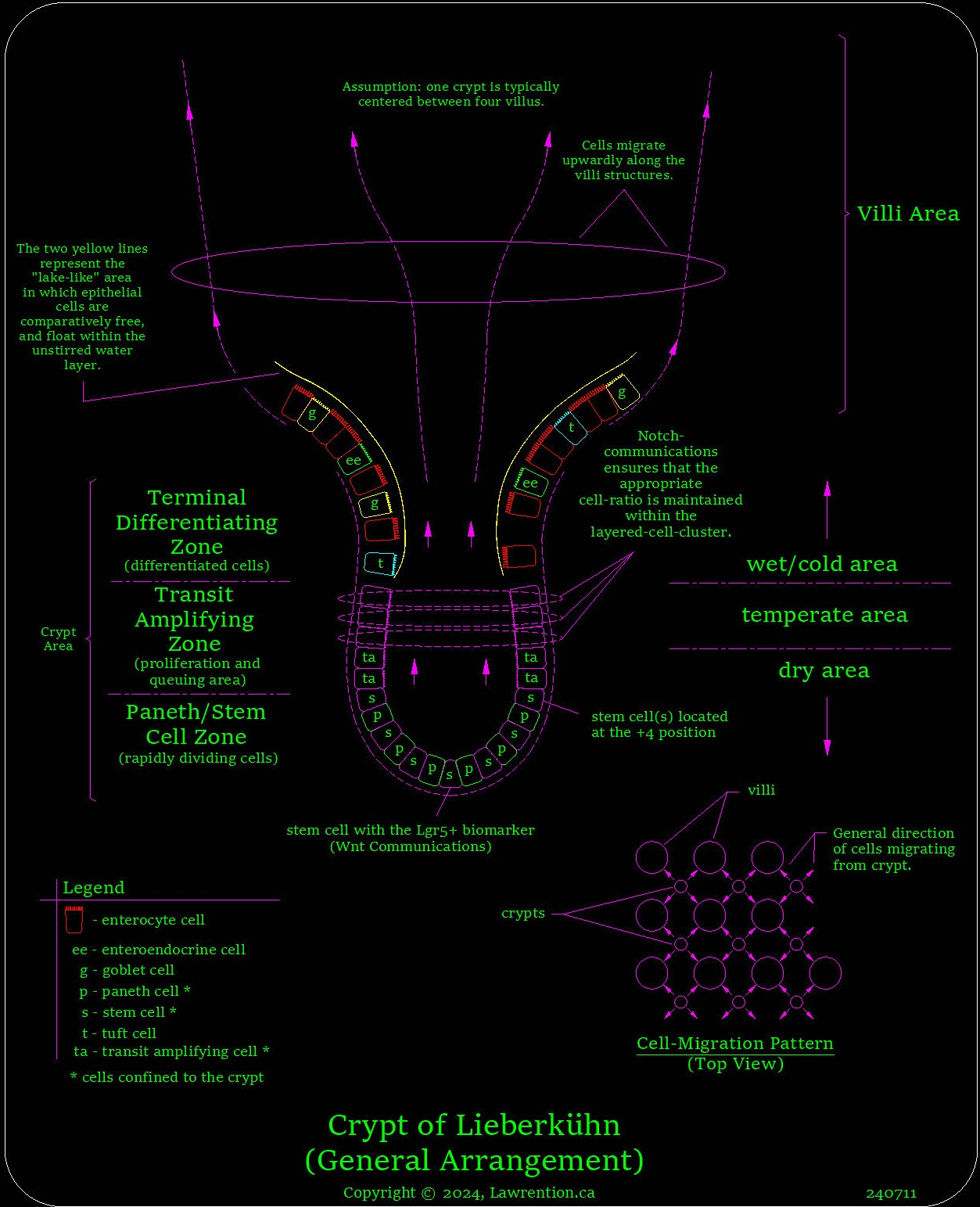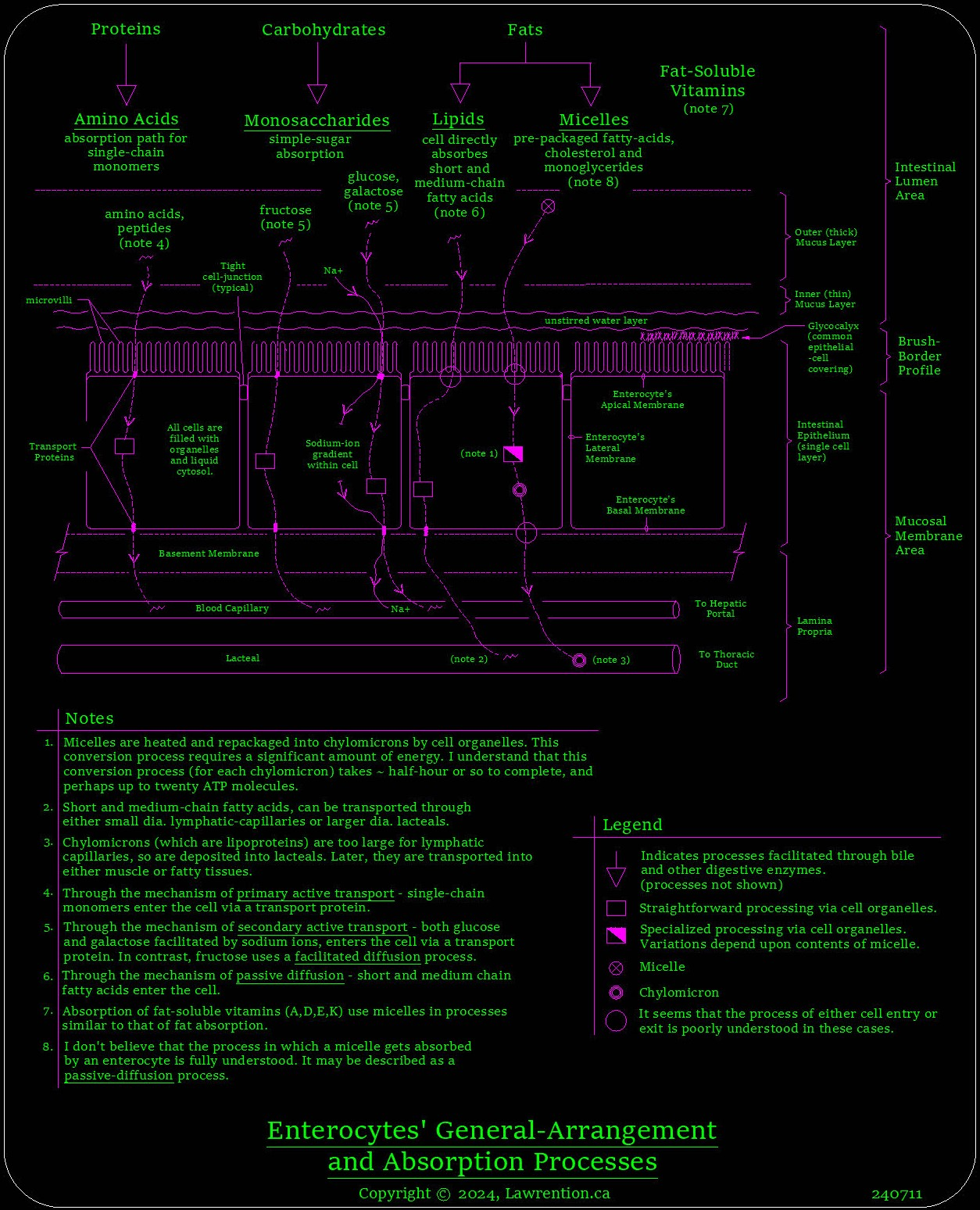Biblical-Based Science
(Published 2024, Revision 241028)
| 🇨🇦 | 🕆 | 🇨🇦 | 🕆 | 🇨🇦 | 🕆 | L🇨🇦 |
This page is a culmination of topics associated with Biblical-Based science; most of which was required in order to support disparate topics on this site.
Biblical-Based Science Topics
- Building Blocks of Intelligence (drawing)
- Electrons are Unique (write-up)
- Class I and Class II Letter-like Particles (write-up)
- Cerebral Spinal Fluid - production and flow (drawing)
- Practical Aspects Regarding the Breath-of-Life (write-up)
- Stem-Cell Action (write-up)
The drawing below depicts crucial aspects of God's creation which obviously occurs after the emergence of God himself. In order to understand this through scientific concepts, I merely refer to the outcome as Class I and Class II particles. The Bible states: "but Christ is all, and in all" (Colossians 3:11). Until I write a specific section on God himself, this drawing is about as fundamental as it gets here on this site.
This drawing aids to explain biological phenomenon such as stem-cells and immune-system cells through the words "intelligence gradient". This intelligence gradient occurs due to a fundamental ratio between Class I and Class II particles. Within the secular world of both chemistry and physics - this underlying ratio could also be considered as an energy gradient.
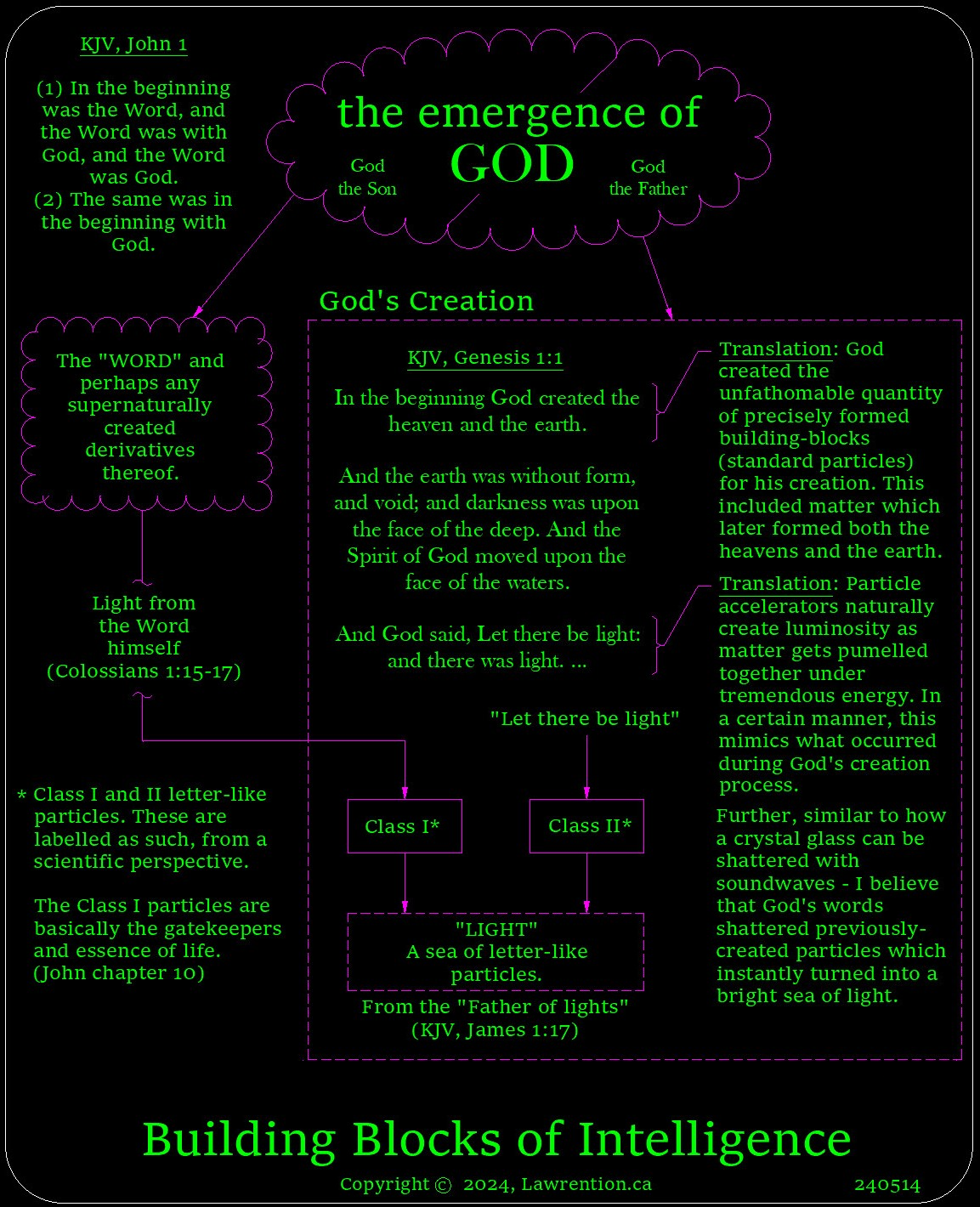
The write-up below with regards to the electron, hinges upon the fundamental Class I & II particles of the previous drawing. This was written to explain the Physical Basis of Spiritual Language, as well as health related topics.
Electrons
Sub-Topic: Electrons are Unique
(Published 2024, version 241201)
As a basis for understanding electrons, consider that they function within a unique environment of spiritual letter-like particles (SLLPs). This is basically a spiritual environment of "light" particles which are sub-sub-atomic in size (sub2-atomic). The environment contains particles magnitudes smaller than an atom, and substantially smaller than the currently understood sub-atomic particles.
Under the discipline of physics, this spiritual environment might be considered to be part of the ether (also spelled as aether); so, it is a major component of the unseen realm. From a biblical-creation stance you can see my basis of reference here.
Further, electrons function within an environment that consists of heterogeneous particle-clouds consisting of SLLPs. These particles comprise the basis for both the spiritual and intelligence aspect of atomic structures.
Under the umbrella of particle physics, electrons are both fundamental and stable particles. From this stance, they cannot be sub-divided into finer (known) components. From an observational standpoint this may be true; however, please humor me for a moment and allow me to explain.
What I'm about to reveal here, doesn't change either an electron's mass nor its elemental charge of -1. In fact, it reinforces some of its commonly-understood characteristics. This includes its magnetic-moment and its ability to carry varying energy-states. For this last case, I'm referring to the atom's quantum-like states.
Under the electron's hood, are particle-like sub-forces which "glue" it together. These sub-forces are comprised of something that looks like numerous-strings which may potentially fan out in multiple directions. At its very center is a solid hub, synonymous to the hub of a spoked wheel.
The electron's "strings" are not loose strings that could go on forever. Nor do I believe that they are sub-components of larger strings, as each electron is a discrete grouping of strings. Likely the best description I can give for now, is that the job of each of these discrete grouping of strings, is like that of a primordial seed. So, the center of an electron is essentially one of these seeds.
These primordial seeds are used within a host of standard-model particles. In fact, I believe that these primordial seeds are common to a number (if not most) of the known standard-model particles in some form or fashion.
Further, I believe that these primordial seeds manifest themselves through the detection of quarks. Since bare-quarks attract mass and are virtually massless themselves... I believe that bare quarks are often-times synonymous with the vacuum-of-space. Each bare-quark is basically a primordial seed. Once mass is garnered though one or more of these seeds (as they can easily be paired or tripled), they reveal differing flavours within the quark family.
Although the hub of each electron appears like strings, I am hesitant to name them as such. Primarily since the topic of string-theory is so broad, that likely many of its theories just don't apply. That being said, obviously the fundamental notion of strings within particle-physics is quite relevant, as differing lengths of strings accommodate a plethora of frequencies via natural rhythms.
Since the electron is so flexible and dynamic, as it mixes with SLLPs - there are various sub-frequencies continually at play. So, if you could hear an electron in action, it's likely playing a tune.
Swirling about the perimeter of every electron, is a plurality of SLLPs. These SLLPs are a homogeneous mix of Class I's & II's. Although both classes are similarly sized, Class I particles house more energy than Class II's, since they were created by quite-dissimilar processes. The electron's environment is basically a sea of these sub2-atomic SLLPs.
The electron looks similar to that of a flexible and very wobbly wagon wheel. It has SLLPs rotating about its perimeter, whereby at its center - is its “glue”.
As the electron continuously spins, it’s the letter-like particles sticking to its perimeter which create the bulk of its mass. The electron continually oscillates within itself, as well as its sub2-atomic environment. Due to its inherent rhythmical and dynamic nature, it continuously attracts and releases SLLPs.
When an electron becomes “full” of these SLLPs, it is basically saturated of both mass and energy. I believe that the moment its saturation-point spikes - is when the electron experiences its "magnetic moment". During this instant, it sheds all of its SLLPs. For a brief moment, only its grouping of short strings and central-hub remain.
After the electron reaches its saturation point, and sheds its numerous SLLPs - it proceeds to relax. At this stage, it doesn’t attract any more SLLPs. In its relaxed state, its still basically spinning. This motion tends to discard loosely-bound SLLPs. After it releases all of its SLLPs and likewise most of its mass, it's shape changes from a comparatively-flat object, to a spherical one.
These discarded SLLP particles remain free. Free, only until they become attracted once again by either the same or different electron. Once an electron's relaxed state is over, its cycle once again resumes and begins to attract SLLPs. As its angular-momentum gains, it morphs itself into the familiar wobbly-wagon-wheel shape once again.
I believe that electrons quickly oscillate between a fully-relaxed and fully-saturated state. How fast this occurs, relies totally upon their environment. As an analogy.... consider that an electron's change-of-state is its breathing mechanism. So, with every breath...... an electron will inhale and exhale a portion of its environment. As a consequence, electrons continually churn up the sub2-atomic sea. If this was a card game, I would say that electrons serve as a means of continually shuffling the deck of SLLPs.
It's the Class I particles versus those of Class II, which are the most energetic. Likewise, they are also the most intelligent. Because of this, Class I particles typically lead chemical reactions. Here, Class I particles can be considered to be the primary constituent in valence electrons. Whereby, the focus is not upon an atom's nucleus, but its perimeter.
Since each electron is capable of having a differing ratio of Class I & II particles, all electrons are unique. From our much-larger human vantage-point - electrons tend to assume characteristics garnered through their most recent "experience" (or environment).
Below, is the electron itself. Although not exactly as depicted, functional-wise - it's fairly close. To date, the electron is used on this site as an aid to explain the spiritual side of matter. At some point I will publish a section dedicated to particle physics; until then, health topics remain the number-one concern.
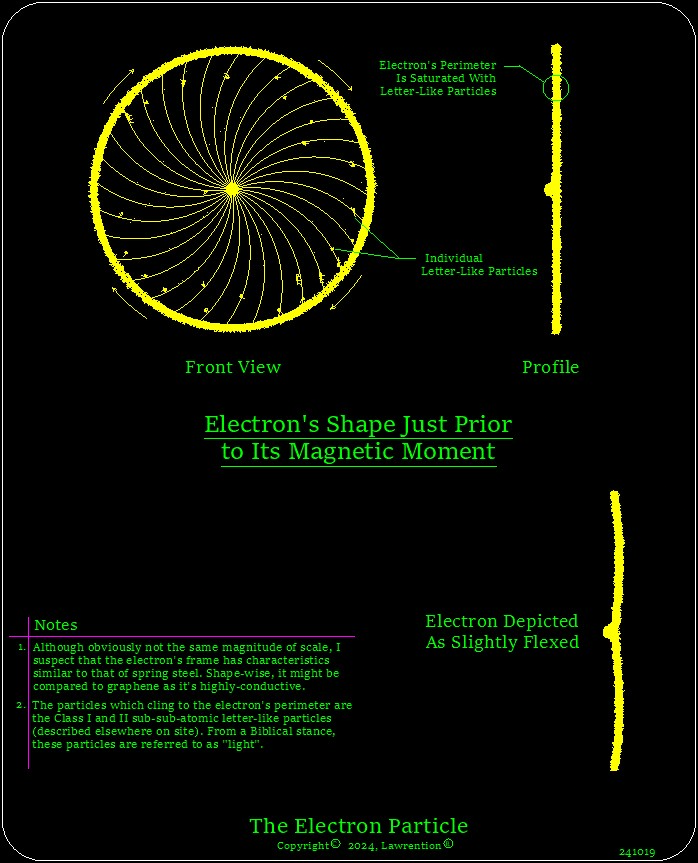
The following was written in order to explain chemical reactions associated with the blood-brain-barrier. It supports one of the main threads (the colour green) within the Health and Longevity document.
Sub-Topic: Class I and Class II Letter-Like Particles (SLLPs)
(Published 2024, version 241125)
Unbeknownst to secular-based science - it is the contrast between Class I and Class II letter-like particles which gives us colour. These two fundamental classes of particles are perhaps the most primordial particles of all. At least as it relates to our presently-understood universe.
The basis of these two fundamental particle groups comes from a biblical-creation stance; some of which you can see here.
Within the book of Genesis, these two classes of particles are referred to as "Light", and are basically spiritual in nature. Hence, the abbreviation for these spiritual letter-like particles is SLLPs.
I believe that SLLPs are many times smaller than those currently understood within the standard-model of particle physics; including that of neutrinos. For this reason, I refer to them as being sub-sub-atomic in size. I surmise that SLLPs make up a substantial part of all electromagnetic-fields and are the primary reason why we experience such a full and finely grained electromagnetic-spectrum.
From a secular standpoint - it's primarily due to these particles' inherent energy or lack thereof, that differentiates the two classes. Furthermore, the Class I group holds a significantly greater amount of energy than those of Class II, regardless that both classes are similarly sized.
Another way of conceptualizing the energetic difference between these two classes, is to consider that Class I particles are much more efficient within any given environment than those of Class II's. The known particles understood through science are often-times a complementary mix between between these two fundamental classes of matter.
Examples of particles which are heavily based upon the energetic Class-I's are shown below.
- Valence electrons.
- Electrons within the highest quantum-state or states.
- Photons comprised of bright-white light.
- Photons emitted through ionizing radiation.
The utilization of various combinations of Class I and Class II particles results in quite a variety of light intensities and wavelengths which our mind interprets as colour. Colour may not actually be colour at all.... but varying intensities of light and shadows that our mind considers as colour.
Note that photons and electrons which have the ability to hold varying energy states, is a direct result of them obtaining differing ratios of Class I & II particles.
Under the science of biology, there are a number of examples where this underlying mix (ratio) between between these two particle classes comes to "light".
- Depending upon the underlying ratio of Class I & II particles, the primary "currency of energy" (ATP) can can be skewed one way or another. This is a fine-tuning mechanism enabling the currency of classical molecular ATP to be fractionally either raised or lowered. So, energy-wise - all ATP molecules don't necessarily have to be equivalent.
- Electrons of the radical-element fluorine contain a very high ratio of Class I particles, and higher than that of elemental-oxygen.
- Monocytes (white-blood-cells) of the immune system contain a high ratio of Class I particles.
- I believe that stem-cells also contain a very-high ratio of Class I particles.
Using monocytes and stem-cells as prime examples, I like to refer to their underlying ratio of Class I & II SLLPs as an intelligence gradient. I find that this term intertwines nicely with a number of currently-understood biological principles.
Within the book of Genesis, it tells us that we should all be eating our greens. Significantly, the colour green is midway through the visible-light spectrum and represents a balanced ratio of these two fundamental classes of matter.
Moreover, the colour green represents food that's neither ripe nor dead and is still in the process of growing. Nutritionally important, is that a food's colour is more fundamental in nature than the vitamins and minerals by which we often-times use to evaluate them.
The following is a schematic showing where the cerebral spinal fluid (CSF) originates within the brain, and how it gets distributed throughout the spine. It was used within the sub-topic of the Central Nervous System.
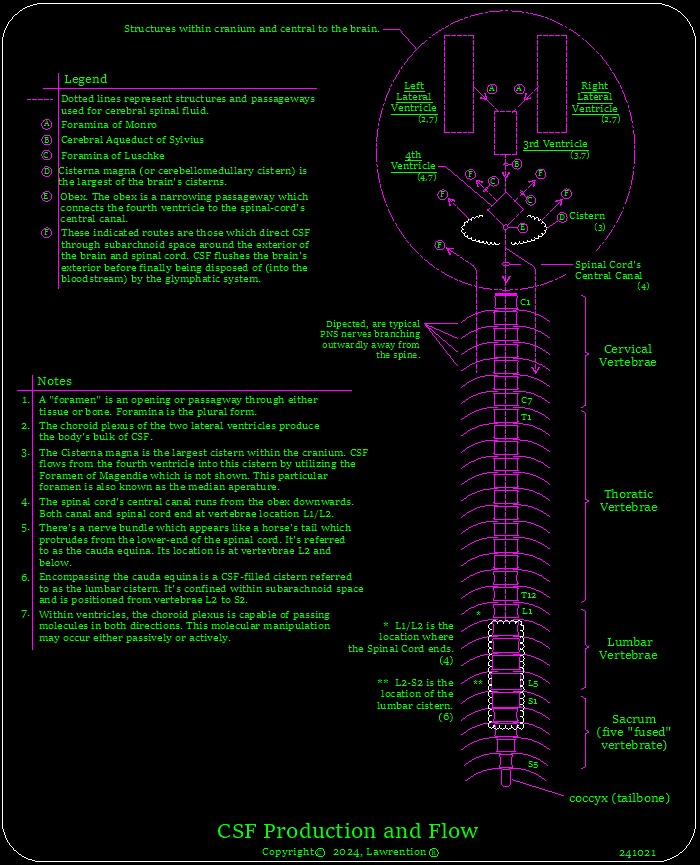
The following two write-ups were written to support an explanation as to how cerebral spinal fluid arises under the sub-topic of the Central Nervous System.
Sub-Topic: Practical Aspects Regarding the Breath-of-Life
Please understand that God’s gift of the Breath-of-Life, was not only required for the brain’s first steps of physical development, but for our conscious identity to arise as well.
From what I understand, this Breath of Life is basically a comparatively dense and heavy particle which serves as an interface between two realms. For simplicity, I will use an analogy to describe its function.
For this analogy, I believe that the breath-of-life works similar to that of a tuning fork which continually vibrates at a certain frequency. The power-source for this “tuning fork” is obtained through a universal energy-constant. In other words, a contiguous backdrop of energy.
As I research physical constructs, perhaps an acceptable manner of describing this backdrop of energy - is through the theoretical-concept of negative mass. Think of this negative mass as being a particle-based colourless fluid and one which is normally attracted to common-mass objects.
This tuning-fork analogy for the Breath of Life, serves as a bridge between common-mass atomic structures and the backdrop of negative-mass particles.
Picture the fixed end of the tuning fork being held firmly in place by negative-mass particles, and having its free end vibrating and interacting with common-mass atomic structures. In this respect, energy is transferred from the fixed end of the tuning fork to its vibrating end. Notably, there is a continual flow of heat-energy travelling in the opposite direction as well.
Similar to a metallic heat-sink, the difference in thermal-conductivity between common-mass and negative-mass.... ensures that energy flows from the vibrating end (the one which reacts with atomic structures) to the fixed end (the opposite end which is held by negative mass).
So, this Breath of Life serves as a bridge between one type of matter and another. The heat energy from common-mass particles that's transferred backwards through the breath-of-life and towards its fixed end - gets dissipated through an invisible sea of
negative-mass
particles.
Sub-Topic: Stem Cell Action
Instead of explaining the conventionally-understood lineage of stem cells, I will leave you with an impression as to how they may function. The Lord led me to this word superposition. It's a common term under the umbrella of particle-physics.
In brief, superposition simply states that particles can be in multiple states (quantum states) at the same time, but can only be observed through a single state.
If we now correlate this concept to stem cells, I believe that it merely infers that stem cells are multifaceted. From this stance, a quick selection (a certain external force) is all that’s required for a particular stem-cell to fixate upon a specific characteristic state. So basically, this selection which is triggered by an external event - forecasts a particular lineage of cells.
The neurological precursor-cells (NPCs) which populate the inside of the neural-tube, might be considered as being undefined and unrefined cells. Although their underlying structure is quite complex; as an NPC - any observed functionality is comparatively crude and subdued.
It is the transference of energy (sound) within the neural-tube which brings NPCs to life, and morphs them into stem-cells for future growth of the central nervous system.
